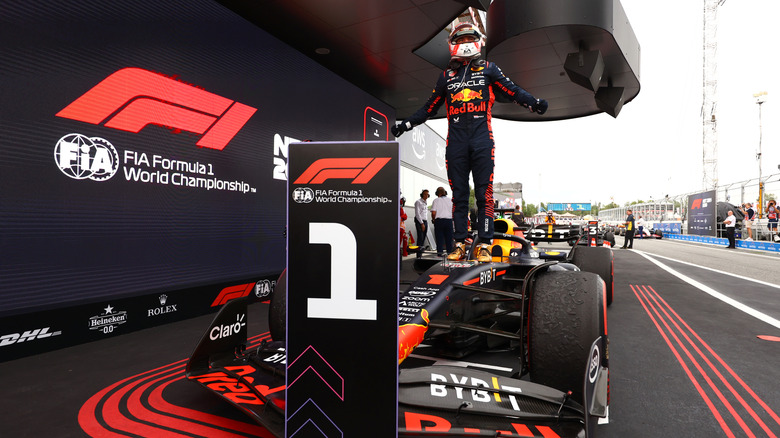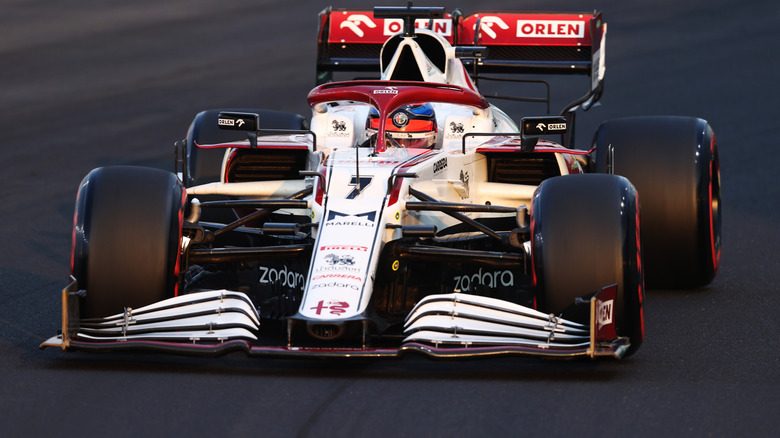F1 Driver Numbers: What Do They Mean, Who Picks Them, & Are Any Banned From Use?
SlashGear has always been here for you to help unravel the lore behind Formula 1 racing. We've provided a crash course for Formula 1 newbies, a breakdown of F1's fastest dozen cars, and our ranking of the best F1 drivers in history. There's also plenty of history behind the numbers on each car, although they have a different meaning in recent years than when the sport was new. Since 2014, each driver has been able to choose the number that goes on the front of their car, with some caveats. No. 1 is reserved for the previous year's champion, who can race with that prestigious digit or their chosen number.
Numbers stay with a driver for their entire career, and drivers can choose any number from two through 99, except for 17. That number was retired in honor of Jules Bianchi, who was involved in a horrific crash at the 2014 Japanese Grand Prix and died nine months later. Drivers weren't always allowed to select their own numbers. In Formula 1's early years, race organizers assigned numbers, sometimes based on the drivers' standings but other times according to their finish in previous races.
Max Verstappen is keeping No. 1 until it's taken from him
In the early '70s, teams were assigned numbers for an entire season, which were based on the squad's performance the previous year. Beginning with the 1974 season, the defending driver's champion was given No. 1, and his teammate No. 2. Jackie Stewart won the 1973 Driver's title, but retired after that season. McLaren got Nos. 5 and 6 for 1974, and Emerson Fittipaldi won the championship in that team's No. 5 car, earning the Nos. 1 and 2 for McLaren for 1975.
Red Bull's Max Verstappen has had a stranglehold on the champion's digit since winning his first title in 2021 in a tight race over Lewis Hamilton. Hamilton never chose the No. 1 after any of his seven championship seasons, six of which came in 2014 or later. "I personally don't like it, I don't like it at all," Hamilton told Motorsport.com in 2021. He made an exception that year, using No. 1 for a single practice session during the season's final weekend in Abu Dhabi. "I thought it would be cool so at least they [his engineers and mechanics] will have a picture of that we were number one."
Hamilton went back to No. 44 for the race, in which Verstappen captured the checkered flag and the driver's championship. The Dutchman immediately swapped his No. 33 for the champion's No. 1, and told Motorsport in January he won't relinquish it voluntarily. ""I can always go back to number 33 if I am no longer world champion," he said. "But as long as I am world champion, I will use number 1 every single year."
Two new full-time drivers will use ex-champions' numbers in 2025
When a driver retires, their number is held in reserve for two years, after which any driver can claim it. Two of the new full-timers for 2025 have chosen numbers used by recent world driver's champions. Jack Doohan raced for Alpine at Abu Dhabi this year in place of the departing Esteban Ocon and will team up with Pierre Gasly in that garage for 2025. Doohan chose No. 7, which was last used by Kimi Raikkonen in the 2021 season. Doohan sported the number in 2019, when he drove for Raikkonen's team in Euroformula Open racing. "I really wanted to go with a number that I raced with before, something that had meaning for me," he told Planet F1. "Also one of my idols, a super special person and driver, Kimi Raikkonen, drove with that number."
Gabriel Bortoleto will race for Sauber next year alongside Nico Hulkenberg, and Bortoleto chose No. 5 for his car. He sported that single digit in 2023, when he won the Formula 3 title. Four-time driver's champion Sebastian Vettel raced with No. 5, but retired after the 2022 season. Kimi Antonelli, the rookie who will hop into Hamilton's seat with Mercedes, chose No. 12. That number was last used by Felipe Nasr in 2016, when he raced for Sauber. Oliver Bearman, who used Nos. 38 and 50 as a fill-in for Ferrari and Haas in previous runs, will race behind No. 87 for Haas when he joins the grid as a full-timer next year.
Raikkonen earned dibs on No. 7 by finishing fifth in 2013
As for the returning and previous F1 drivers, they have varied reasons for choosing their respective numbers. Carlos Sainz wanted No. 5, but Vettel was using it when Sainz broke into F1 with Toro Rosso in 2015. Sainz chose the next best thing: two fives. Valtteri Bottas desired lucky No. 7, but Raikkonen got priority because he had finished fifth in the 2013 driver's standings, 12 spots ahead of Bottas. Bottas doubled up and went with No. 77, but he wasn't the only driver beaten to No. 7 by Raikkonen. Bianchi wanted Nos. 7, 27, and 77, but his 19th-place finish in 2013 placed him near the back of the selection line. He ended up with No. 17, which is now retired in his honor. No. 27 went to Hulkenberg, after previously being on the cars of F1 champions Ayrton Senna, Alain Prost, Alan Jones, and Nigel Mansell.
Several drivers used their F1 numbers in their karting days
Hamilton's career-long fealty to No. 44 is the result of happenstance. When he began karting at the age of eight, he and his father borrowed 44 from the license plate on the family car when asked to choose a number for their entry. Hamilton also used No. 44 two years later, when he won the British cadet class karting championship. His current Mercedes teammate George Russell also leaned on family carting history to select his F1 number. His brother raced karts with No. 63, and Russell is quoted on the Formula 1 website saying, "He always had number 63, so that's been the family number ever since." Fernando Alonso chose No. 14 because "It has always brought me luck, dating back to 14th July 1996 when I won the world championship in a kart that had the number 14."
Ocon won the 2007 French karting championship with No. 31, and said, "It's still my most successful year to date. That's why I will go 31 for the rest of my career." In his early karting days, Oscar Piastri was faced with a conundrum. For his first race, the shop he used only had ones available, so he went with 11 until he got to a state championship in where the number was already in use. "I don't know what inspired me to pick 81 but I changed the first one for a number eight," he said, "and it stuck ever since."
Some drivers took inspiration from other athletes
Like Bortoleto, Aston Martin's Lance Stroll won the Formula 3 championship with the number he chose for his Formula 1 car. "[No. 18] means a lot to me," he said. "I've just stuck with it ever since and I don't want to change." Former Alfa Romeo driver Zhou Gyanyou got his inspiration from another sport. "Kobe Bryant was a big inspiration to me when I was more interested in basketball than motorsports," Zhou explained. "What impressed me most was his work ethic."
Gasly had more than one reason for choosing No. 10 for his Formula 1 ride. He used the number in 2013 when he won the Formula Renault European championship, and also uses it as a tribute to French footballer Zidene Zidane. Nyck De Vries sported No. 21 for the first half of 2023, when he raced for Alpha Tauri before being replaced by Daniel Ricciardo. He used No. 17 while in Formula E, but was forbidden from using that number in Formula 1. In 2014, Ricciardo explained on the Formula 1 website that he chose No. 3 because "It was my first ever number in karting and I was also a fan of Dale Earnhardt." Alex Albon used No. 46 in his karting days as a tribute to nine-time Moto GP champion Valentino Rossi, and divided that number in half for his No. 23 Formula 1 assignation.





